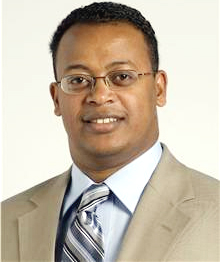Surviving Medical School in Ethiopia
 By Dr Surafel K Gebreselassie
By Dr Surafel K Gebreselassie
I don’t know how we did it. We did it anyway.
At least three of us had tuberculosis as far as I can remember. That would be 10% of the class of 1996. My symptoms were not as bad compared to my other two friends. It all started with four people, three medical students and a patient with open tuberculosis. There were no masks, if there was one we didn’t pay enough attention.
Cough, take a deep breath,
Cough, take a deep breath.
The patient didn’t disappoint us.
He coughed and coughed in front of us.
We pressed and listened to his chest, anxious to report the fluid that we picked in his lung, to the uncompromising professor.
If you couldn’t diagnose tuberculosis, you are no doctor.
That was for sure.
The professor would pull up the x ray later.
We were right on the spot; the left lung had fluid in it.
Mycobaterium tuberculosis was first discovered in 1882 by Robert Koch, the founder of modern bacteriology and winner of the Nobel Prize in Medicine in 1905, but the disease is perhaps as old as mankind bearing different names such as white plague, consumption.
It sure was consumption. It started to chip away my energy just when I needed it, right before the exam. I was tired and weak. Profuse sweating at night became a nuance. The loss of appetite followed. I was spared of the bad cough, at least initially so I wasn’t suspecting. The punishing schedule sure can make you sweat and lose appetite, so took the blame.
When I started to cough up phlegm, I knew that I was in deep trouble.
I picked up a sample and headed to the lab.
“Who are you?â€Â
I am a medical student.
“What do you do here in this odd hour?â€Â
I came here to do acid fast stain.
“Do you know how to do it?â€Â
I had an A in Parasitology class.
 I answered the head of the lab with unease but I knew the follow up question would be difficult to answer. I didn’t want to tell him my lower grade in Microbiology. I had the staining steps memorized and knew what the bacteria looked under the microscope, red dots because it resists decolorization with acid rinse and takes up the initial red color of the dye, carbol-fuchsin.
He looked at me straight in the eye; an old man, perhaps in his 60s.
Sixty years of Ethiopian life at any time will easily make you old with no complaints because you have already made it beyond the life expectancy anyway.
He was head of the microbiology lab. I was still standing by the door to get a permission to get in when he approached me.
“You look sick,†he said.
I broke down in tears.
He stopped what he was doing and took the sample from my hand. He stained it himself and summoned me to look at it with him.
“Look where the pointer is,†he said.
“You have it.â€Â
Tuition, housing, basic food and medical care were free in medical school. Pay back was mandatory service for few years in government hospitals after graduation.
I checked in Jimma Hospital to be treated for tuberculosis. I joined the other two students who beat me by few days.
History is full of stories of many who suffered from tuberculosis.
Such as author Edgar Allen Poe and poet John Keats
The bacterium was also found in ancient Egyptian mummies.
I was not afraid; we were in a different era. Roentgen discovered X ray in 1895 and made it easier to diagnose.  Long before I fell for it, treatment was established starting with the discovery of streptomycine in 1944 and INH in the 1950s, followed by many more.
Soon every one found out that after all I was eligible for high protein diet, two boiled eggs added to the evening campus meal.
Two boiled eggs every day! That was a lot of protein but more importantly it helped me eat the rest of the plate, stew made of lentils, chickpeas on most days.  Classmates would take turns to share one of the eggs.
Two to four weeks in to my treatment,
I regained my appetite.
The fever slowly went away.
The cough eventually disappeared.
I passed the exams with flying colors.
I continued to get those boiled eggs way beyond the 6 month of the intensive treatment.
It is a bittersweet memory.
About Dr. Surafel K Gebreselassie
I am an Ethiopian physician trained at Jimma Institute of Health Sciences ( now Jimma University, in Jimma, Ethiopia) and Wayne State Uiversity ( Detroit, MI, USA). I teach and practice Nephrology and Hypertension at Cleveland Clinic.
Please visit:
- His blog here: http://ksurafel.com/.
- Dr. Gebreselassie’s profile at Cleveland Clinic.
_____________________________________________________________
Video: Dr. Surafel Gebreselassie, MD
Internist, Nephrologist (kidney) in Cleveland, OH
Take a minute to learn about Dr. Surafel Gebreselassie in this video. If you’d like to learn more, click on one of the links below.

